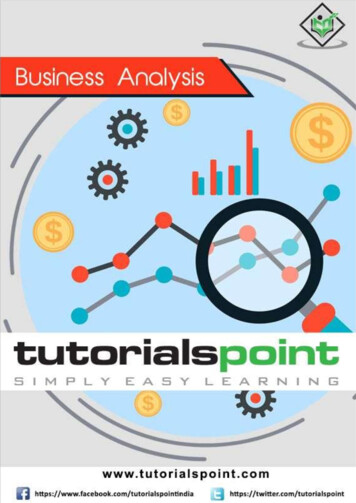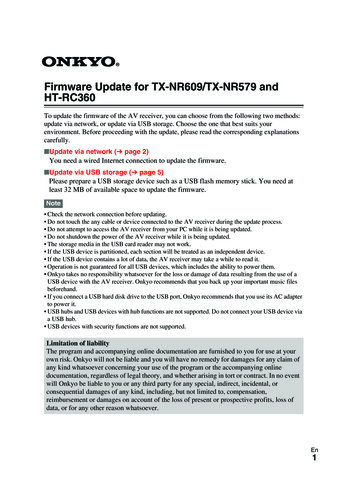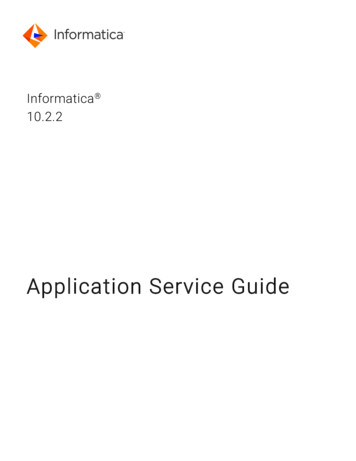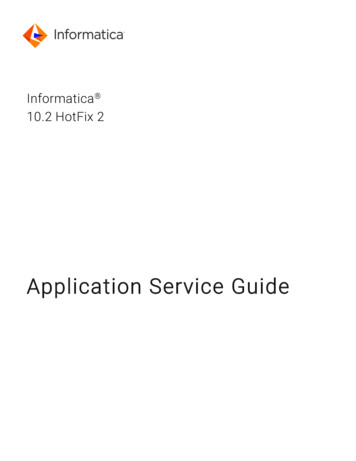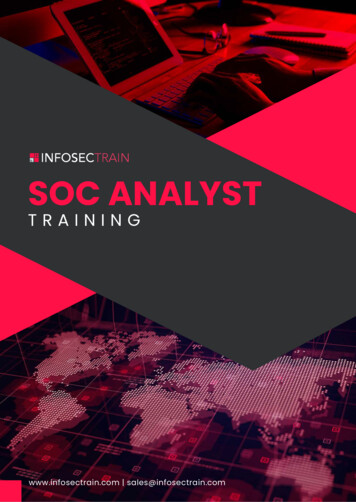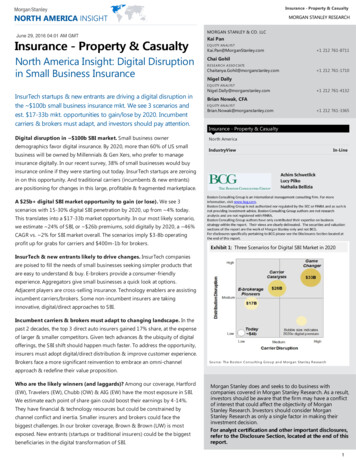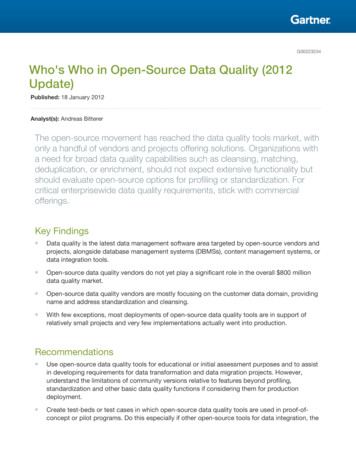
Transcription
G00223234Who's Who in Open-Source Data Quality (2012Update)Published: 18 January 2012Analyst(s): Andreas BittererThe open-source movement has reached the data quality tools market, withonly a handful of vendors and projects offering solutions. Organizations witha need for broad data quality capabilities such as cleansing, matching,deduplication, or enrichment, should not expect extensive functionality butshould evaluate open-source options for profiling or standardization. Forcritical enterprisewide data quality requirements, stick with commercialofferings.Key Findings Data quality is the latest data management software area targeted by open-source vendors andprojects, alongside database management systems (DBMSs), content management systems, ordata integration tools. Open-source data quality vendors do not yet play a significant role in the overall 800 milliondata quality market. Open-source data quality vendors are mostly focusing on the customer data domain, providingname and address standardization and cleansing. With few exceptions, most deployments of open-source data quality tools are in support ofrelatively small projects and very few implementations actually went into production.Recommendations Use open-source data quality tools for educational or initial assessment purposes and to assistin developing requirements for data transformation and data migration projects. However,understand the limitations of community versions relative to features beyond profiling,standardization and other basic data quality functions if considering them for productiondeployment. Create test-beds or test cases in which open-source data quality tools are used in proof-ofconcept or pilot programs. Do this especially if other open-source tools for data integration, the
database management system, or business intelligence (BI) are under consideration, as thiscreates a consistent cost model and work approach. Considering the market convergence of data quality tools with data integration platforms, lookfor data quality solutions that are easily integrated into data integration data flows. Since a data quality problem cannot be solved by technology alone, the cost-saving promise ofopen source is only one aspect. Organizations must still invest in proper data quality processes,data stewardship and other nontechnical areas. In addition, while software licensing costs maybe lower for open source, functional limitations require you to augment the tool, which raisescosts.Table of ContentsStrategic Planning Assumption(s).3Analysis.3Market Definition.3The State of Open-Source Data Quality.4Talend.5Human Inference.6SQL Power.8Infosolve.9Other Projects.10Bottom Line.10Recommended Reading.11List of TablesTable 1. Data Quality Functional Requirements.4List of FiguresFigure 1. Sample Screen of Talend Open Studio for Data Quality.6Figure 2. Sample Screen of DataCleaner.8Figure 3. Sample Screen of DQguru .9Page 2 of 12Gartner, Inc. G00223234
Strategic Planning Assumption(s)In the first iteration of this document (published in 2009) we included the following StrategicPlanning Assumption:"All open-source data quality projects combined will reach just 3% to 5% market penetration(subscribed customers) up to 2012. It will likely be well beyond 2012 before open-source dataquality tools have broadly caught up in terms of their capabilities with the commercial data qualitytools vendors."This prediction from 2009 turned out to be valid, as far as overall adoption rates are concerned.After the initial spike in open-source data quality, the large number of offerings had died down,adoption progressed only slowly, and no new projects had started. In the future, this submarket willlikely find it even harder to stand on its own. The commercial market is already very fragmented,lower-cost cloud offerings are entering the space, and the convergence of data integration and dataquality makes it increasingly hard for an open-source data quality project to survive in the long term.AnalysisThe information management technology markets have seen a large number of vendors approachthe space with an open-source strategy. Open-source products have been made available fromdatabase management systems (such as MySQL and Ingres), BI tools (such as Jaspersoft andPentaho) and data integration tools (such as Talend and Jitterbit, see "2009 Sees IncreasedAdoption of Open-Source Data Integration Tools"), to content management (such as Alfresco andconcrete5) and document management (such as OpenKM and Epiware). The latest area to see thefirst open-source offerings is the data quality software market. While significantly smaller than thedatabase management system or BI markets, it is still estimated to be worth around 800 million.This represents a large enough opportunity for open-source vendors to have a go at entering themarket, even though it is dominated by large infrastructure vendors such as IBM, SAPBusinessObjects, Informatica and SAS/DataFlux.Market DefinitionAs outlined in "Magic Quadrant for Data Quality Tools" the vendors participating in this market offerstand-alone software products that address the core functional requirements of the data qualitydiscipline (see Table 1).Gartner, Inc. G00223234Page 3 of 12
Table 1. Data Quality Functional RequirementsTechnologyDescriptionProfilingThe analysis of data to capture statistics (metadata) that provide insight into the qualityof the data and help identify data quality issues.ParsingThe decomposition of text fields into component parts.StandardizationThe formatting of attribute values into consistent layouts based on industry and localstandards (for example, postal authority standards for address data), user-definedbusiness rules and knowledge bases of values and patterns.CleansingThe modification of data values to meet domain restrictions, integrity constraints orother business rules that define when the quality of data is sufficient for the organization.MatchingIdentifying, linking or merging related entries within or across datasets.MonitoringDeploying controls to ensure data continues to conform to business rules that definedata quality for the organization.EnrichmentEnhancing the value of internally held data by appending related attributes from externalsources (for example, consumer demographic attributes or geographic descriptors).Source: Gartner (January 2012)In addition to the above functionality, vendors participating in the data quality tools market oftenprovide connectivity to a range of different data structure types and adapters to third-partytechnology and data providers (for example, for address validation, or telephone number or bankcode verification). Typical data providers are postal organizations in various countries, telephoneoperators or banking networks. Data quality tools also often connect to credit bureaus, blacklist orwatchlist providers, or vertical industry data sources (for example, for manufacturing or healthcare).Other data quality tools' capabilities include: standardization for specific data subject areas;international support; metadata management; a configuration environment for managing anddeploying data quality rules; data quality workflow support for various data quality roles such asdata stewards; and support for service-oriented architecture deployments. For more information onhow to select suitable data quality tools, refer to "Toolkit: RFP Template for Data Quality Tools."The State of Open-Source Data QualityAs in the BI and data integration markets, open-source data quality vendors will slowly start toappear and then play catch-up with the established commercial vendors. At the time of writing,there have been only a handful of attempts on the market, with varying degrees of potential andsuccess.Initial open-source projects have centered on data profiling. This makes sense as newcomers todata quality can start doing initial assessments of their data without investing in fully-fledged dataPage 4 of 12Gartner, Inc. G00223234
quality platforms. Since data profiling is also recommended during early phases (even of broad dataquality initiatives), even organizations fully committed to a data quality program could distributeopen-source data profiling software to multiple users in various departments. This enables them toget a broad overview of potential data quality issues, again, without a large upfront investment.Later on, those companies would typically look at broad data quality capabilities (see Table 1) anduse their existing relationships with infrastructure vendors, or pick a smaller vendor that is morelocal. The data profiling tools can also be used in projects other than data quality. For example, tounderstand the structure and the content of data sources in advance of building extraction,transformation and loading (ETL) routines for a data warehouse, or within a data migration project.Another use case for open-source data quality is application development. Data profiling tools canbe used to inspect data sources that the developer needs to connect to, verify database recordsafter write operations, or validate in-database operations.Well-known technology providers in the BI and data integration markets have expanded theirfootprint into the data quality area, often through acquisitions. Open-source vendors in the BI anddata integration markets will progress in the same way. During the merger and acquisition frenzy awhole raft of data quality vendors were taken over, including: AddressDoctor, Ascential, Avellino,DataFlux, Datanomic, Evoke, Firstlogic, Fuzzy Informatik, Global Address, Group 1, QAS, IdentitySystems, Netrics, Silver Creek Systems, Similarity Systems, Vality and Zoomix. After this the opensource equivalents started to expand their portfolios and move into data quality software. Becausethe data quality tools market is only about 10% of the size of the BI platform market, softwareproviders are entering it much less aggressively and the vendor landscape remains relatively stable.TalendSuresnes, France and Los Altos, Californiawww.talend.comThe best known company for offering open-source data quality is Talend. While it was not the firstever available open-source data quality tool, it is now the most advanced of all open-sourcealternatives. The company provides two types of data quality software: the Talend Open Studio forData Quality, a freely downloadable and limited functionality version of the fuller featured product;and Talend Enterprise Data Quality, which includes additional capabilities for cleansing, matchingand report generation. Talend reports that about 120 of its commercial customers buy the dataquality product, still a small portion of its 2,000 customer base, most of which subscribed toTalend's data integration product. The Unicode-enabled Talend Open Studio for Data Quality (seeFigure 1) includes basic functions for data analysis, pattern discovery, SQL business rules, datadrill-down and rudimentary results visualization. For an initial data investigation, which may includeexamining the existence and validity of attribute values, data ratios, uniqueness of keys, ororphaned records, the tool is "good enough." However, users will very quickly hit the tool's limitsand require better connectivity to more data sources, and better matching, cleansing andvisualization capabilities. That is where the commercial package, Talend Enterprise Data Quality, ispositioned.Gartner, Inc. G00223234Page 5 of 12
Figure 1. Sample Screen of Talend Open Studio for Data QualitySource: TalendIn combination with its main product, Talend Enterprise for Data Integration, users gain connectivityadapters to more data source types, including third-party data providers, such as Dun&Bradstreet,or publicly available datasets, such as census data. Because Talend does not provide any addressvalidation capabilities itself, the company has struck a technology agreement with Experian QAS, arecognized provider of address verification solutions with connectors to Uniserv, AddressDoctorand the Google Geocoding API. Talend built a data stewardship console into its product,addressing the increasing need for nontechnical staff to monitor and manage data quality issuesdetected during data flows. The data quality dashboard, while a bit basic in its visual capabilities,shows widgets about important metrics, indicating the status of the data profiled, matched,cleansed or deduplicated. With Talend's additional acquisitions, Amalto and Sopera, the vendor isexpanding its vision of a "unified integration platform" and following the major convergence trend ofdata quality, data integration, and master data management technologies.Human InferenceArnhem, The Netherlandswww.humaninference.comIn February 2011, Human Inference, a Dutch vendor of commercial data quality tools, announcedthe acquisition of the Danish eobjects.org project, which provides DataCleaner, an open-sourcedata profiling tool that started in Denmark in 2007. After the acquisition, eobjects.org became adivision of Human Inference, focusing on supporting the open-source data quality community.Page 6 of 12Gartner, Inc. G00223234
Human Inference has an established brand in Europe, particularly in the Benelux countries, whileeobjects.org has few customers, a tiny community that shows very little activity, no revenue andalmost no visibility in the market. Human Inference bought eobjects.org to attract small businesseswith a free data profiling tool so that it can sell them its own commercial tools later on when theirneeds grow. DataCleaner serves as a seeding strategy for departmental assessments of dataquality in larger enterprises. Human Inference may try to upsell DataCleaner users to its softwareas-a-service offering for data cleansing. However, DataCleaner’s Java application already sports the"Powered by Human Inference" logo, and the product is not integrated with Human Inference's ownproducts. Human Inference offers no migration path from DataCleaner to the commercial HIqualityset of products. Even if customers decided to upgrade, it would largely be a new implementation.The DataCleaner software consists of a quick download and an easy installation, including somesample data (customers, employees, departments, products, orders, payments) that allows you totry out the profiling functionality.Out-of-the-box database connectivity includes MySQL, Oracle, PostgreSQL, Microsoft SQL Serverand a few minor Java database brands. Additional database drivers can be installed automatically inthe user interface (UI). In addition, DataCleaner can read from comma-separated or tab-separatedvalue files, Microsoft Excel spreadsheets, Microsoft Access database files, fixed width files,OpenOffice, XML and regular text files, which is sufficient for profiling projects. Support for moredata formats can be created as extensions.Profiling options include standard measures, string, time and number analysis, pattern detection,value distribution, character set distribution and a variety of matching options, against dictionaries,regular expressions, synonym catalogs and masks. Through enabling multiple databaseconnections and multithreading, performance can be tuned, based on the corresponding databasesupport. DataCleaner provides filtering and transformation components for preprocessing data,along with a few target data writers, making it possible to use the tool as a lightweight ETL engine,for example, for one-time migrations. Profiling results include various counts, minimum andmaximum values, and averages. However, the lack of more advanced data quality functionality,such as cleansing, matching or monitoring, makes DataCleaner somewhat limited in its usefulnessand requires an upgrade to the full-fledged HIquality suite, Human Inference's commercial product.Still, data architects or application developers who can live with the rather basic UI may find theDataCleaner tool useful for investigating database content, potential inconsistencies or other datarelated issues.With version 2.0, DataCleaner's UI has undergone a facelift, although with mixed results. The toolprovides a rather awkward user experience, suited more for the tech-savvy developer than for atypical data steward. Continuously overlapping windows, a distracting high-contrast color schemeand an unfortunate distribution of screen real estate make DataCleaner a cumbersome tool. Figure2 shows a sample screen shot of the DataCleaner product.Gartner, Inc. G00223234Page 7 of 12
Figure 2. Sample Screen of DataCleanerSource: Human Inference/DataCleanerSQL PowerToronto, Canadawww.sqlpower.caAlthough SQL Power does not position itself as an open-source software company, the vendor stilloffers various products under a General Public License (GPL) V3 open-source agreement, some ofwhich are freely downloadable, including: the Wabit reporting tool; Power*Architect, a datamodeling and profiling tool; and DQguru, positioned as a data cleansing and master datamanagement (MDM) tool. Similar to Human Inference's DataCleaner tool, the profiling segment ofPower*Architect provides a variety of counts (rows, nulls, unique values) and calculates minimum,maximum and average values. The tool is obviously targeted at architects, hence the inclusion ofETL functionality (visual mapping and creating jobs, based on Pentaho's data Kettle integrationtool), as well as online analytical processing schema management functionality. The profilingcapabilities are clearly not targeted at nontechnical end users, such as data stewards, as the toolrequires decent knowledge of database operations from Java Database Connectivity to schemamodeling. The inclusion of a feature for "universal SQL access" also indicates that this tool istargeting technology-savvy users who thoroughly understand the world of SQL and DBMSs.SQL Power's second open-source offering pertaining to data quality is DQguru (see Figure 3). It israther unclear why profiling is bundled with modeling and cleansing is bundled with master dataPage 8 of 12Gartner, Inc. G00223234
management (MDM). In fact, calling DQguru an MDM tool is not particularly accurate. As far ascleansing functionality is concerned, the tool provides what it calls "projects" for deduplication,cleansing and address correction. The latter is supported by a DQguru subscription, which providesusers with a monthly copy of the Canada Post database. For addresses outside Canada there iscurrently no validation capability. The only other correction facility comes from a feature named"translate words manager," by which abbreviated words, such as ave, bldg, corp or dept can bemapped to the proper spelling of avenue, building, corporation and department, respectively. This,of course, would not be considered address correction, but rather standardization. Figure 3 shows asample screen shot of a DQguru matching process.Figure 3. Sample Screen of DQguruSource: SQL PowerInfosolvePrinceton, New Jerseywww.dataqualitysolution.comInfosolve can barely be considered an open-source vendor as its business model is radicallydifferent than most other software vendors carrying the open-source moniker. One could argue thatInfosolve is actually a services company that happens to own a number of software products thatthe company implements for its clients. In contrast to the typical open-source vendors, InfosolveGartner, Inc. G00223234Page 9 of 12
does not provide any products to download, even for evaluation purposes. In that sense, "opensource" is somewhat of a misnomer, although clients receive the implemented software (includingthe source code) without any licensing charge. Customers can also re-distribute the source codeunder a GPL 2.0 agreement.Infosolve's software portfolio, branded under the rather odd name of "zero-based data solutions,"includes the OpenDQ and OpenCDI products, along with functionality for data integration,migration, conversion, mining and enhancement. The OpenDQ product provides profiling,standardization, various kinds of matching and merging, deduplication, and Web services-basedexternal data enrichment. Address validation is provided for 240 countries through an agreementwith AddressDoctor (now part of Informatica). Infosolve's go-to-market model is based on itsconsultants building specific data quality solutions for its clients. While prospects may get access tothe software for a proof-of-concept implementation ahead of a full-blown and chargeabledeployment, organizations that are looking for a simple download and installation, or have no needfor external consultants doing implementations, will likely bypass Infosolve as a potential dataquality tools provider.Other ProjectsSimilar to other open-source software domains, a few defunct data quality projects remain on theInternet. Organizations should steer clear of open-source data quality zombies such as dwSavvy(www.dwsavvy.com/dwsavvy data profiling), ChkDb (www.agt.net/public/bmarshal/chkdb),Berkeley University's Potter's Wheel (control.cs.berkeley.edu/abc) and Arrah (sourceforge.net/projects/dataquality), as there seems to be no more development work and support. Similarly, whilethe Java community named Mural (mural.dev.java.net) still seems to have some life in it, its dataquality subproject, Open-DM-DQ (open-dm-dq.dev.java.net), appears to have reached the end of itslife, as there are no more recent updates available. Then there is the DataNucleus(www.datanucleus.org/products) Access Platform, an ongoing and well-documented open-sourceproject which claims to do data quality and data profiling. However, on closer inspection, theplatform is really only enabling persistence of Java objects to a relational database managementsystem, db4o, Lightweight Directory Access Protocol, Excel and other data stores, licensed underan Apache 2 agreement.Bottom LineNearly all open-source data quality tools offerings must be considered largely toolboxes for techies,with Talend being a reasonable exception, as the vendor has even been included in "MagicQuadrant for Data Quality Tools." Still, none of the open-source platforms reach the capabilities ofthe commercial market leaders in the data quality arena. However, the described open-sourceofferings may be helpful as a starting point for generic data quality initiatives. Commercial dataquality vendors also typically provide best practices about data governance and stewardship,metadata and MDM. However, most open-source data quality vendors miss those aspects entirely.An increased adoption of data quality tools in the market can be observed and this will also help theopen-source projects to gain more visibility, but the general worldwide adoption of open-sourcedata quality tools will grow only very slowly. Rather than expecting a slew of new vendors orprojects entering the space, it can be assumed that the number of offerings has stabilized.Page 10 of 12Gartner, Inc. G00223234
Recommended Reading"Magic Quadrant for Data Quality Tools""Gartner's Data Quality Maturity Model""Toolkit: RFP Template for Data Quality Tools""Hype Cycle for Data Management, 2011""Hype Cycle for Open-Source Software, 2011"Acronym Key and Glossary TermsBIbusiness intelligenceCDIDBMScustomer data integrationdatabase management systemDQdata qualityETLextract, transform, loadGPLgeneral public licenseMDMmaster data managementSQLstructured query languageGartner, Inc. G00223234Page 11 of 12
Regional HeadquartersCorporate Headquarters56 Top Gallant RoadStamford, CT 06902-7700USA 1 203 964 0096Japan HeadquartersGartner Japan Ltd.Atago Green Hills MORI Tower 5F2-5-1 Atago, Minato-kuTokyo 105-6205JAPAN 81 3 6430 1800European HeadquartersTamesisThe GlantyEghamSurrey, TW20 9AWUNITED KINGDOM 44 1784 431611Latin America HeadquartersGartner do BrazilAv. das Nações Unidas, 125519 andar—World Trade Center04578-903—São Paulo SPBRAZIL 55 11 3443 1509Asia/Pacific HeadquartersGartner Australasia Pty. Ltd.Level 9, 141 Walker StreetNorth SydneyNew South Wales 2060AUSTRALIA 61 2 9459 4600 2012 Gartner, Inc. and/or its affiliates. All rights reserved. Gartner is a registered trademark of Gartner, Inc. or its affiliates. Thispublication may not be reproduced or distributed in any form without Gartner’s prior written permission. The information contained in thispublication has been obtained from sources believed to be reliable. Gartner disclaims all warranties as to the accuracy, completeness oradequacy of such information and shall have no liability for errors, omissions or inadequacies in such information. This publicationconsists of the opinions of Gartner’s research organization and should not be construed as statements of fact. The opinions expressedherein are subject to change without notice. Although Gartner research may include a discussion of related legal issues, Gartner does notprovide legal advice or services and its research should not be construed or used as such. Gartner is a public company, and itsshareholders may include firms and funds that have financial interests in entities covered in Gartner research. Gartner’s Board ofDirectors may include senior managers of these firms or funds. Gartner research is produced independently by its research organizationwithout input or influence from these firms, funds or their managers. For further information on the independence and integrity of Gartnerresearch, see “Guiding Principles on Independence and Objectivity” on its website, omb guide2.jsp.Page 12 of 12Gartner, Inc. G00223234
Figure 1. Sample Screen of Talend Open Studio for Data Quality Source: Talend In combination with its main product, Talend Enterprise for Data Integration, users gain connectivity adapters to more data source types, including third-party data providers, such as Dun&Bradstreet, or publicly
